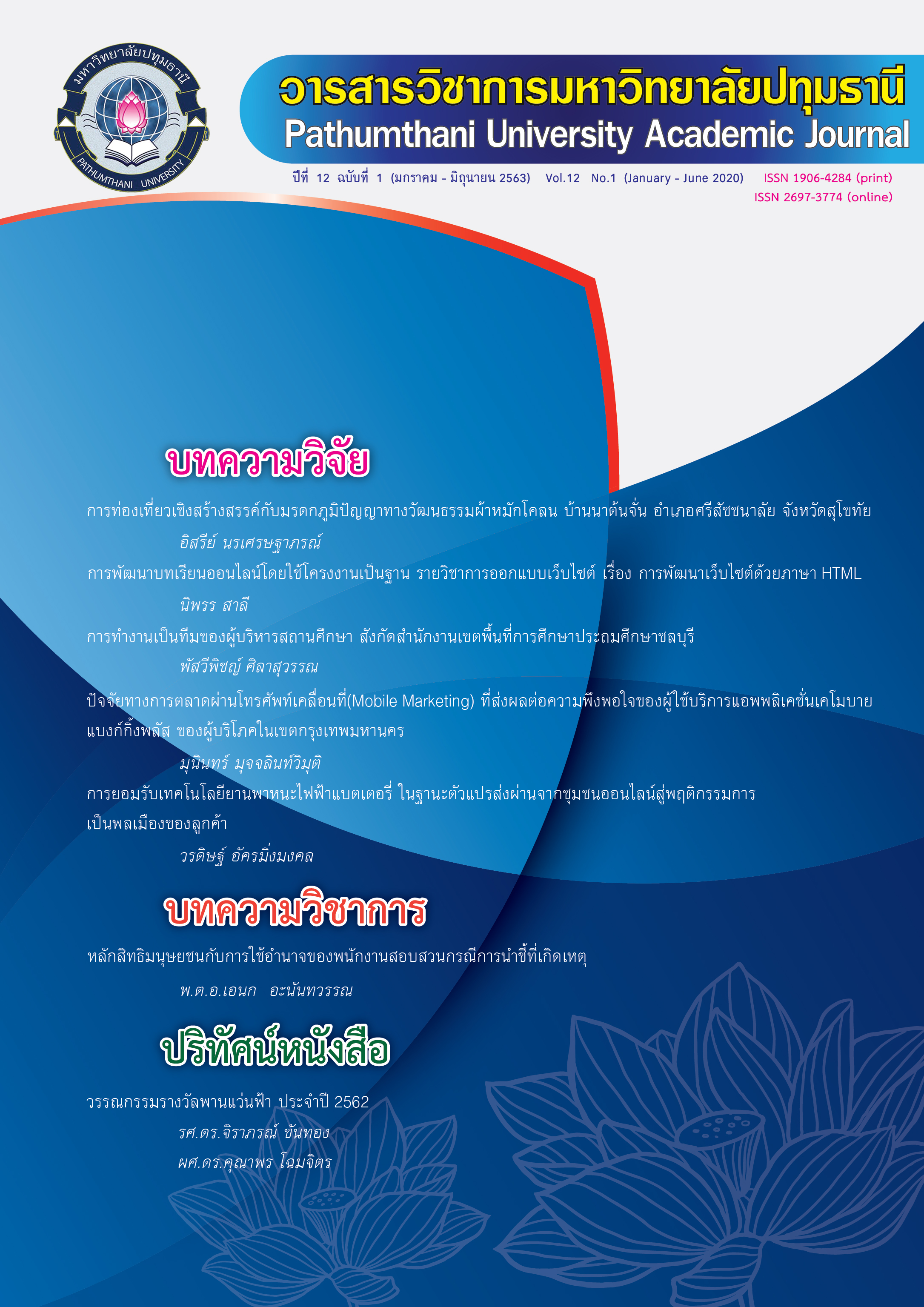THE CREATIVE TORUISM AND INTANGIBLE CULTURAL HERITAGE MUD SOAKED TEXTILES (PHA MAK KLONE) AT BAN NA TON CHAN SISATCHANALAI DISTRICT SUKOTHAI PROVINCE
Keywords:
Creative Tourism, Intangible Cultural Heritage, Pha Mak KloneAbstract
The objective of this research is to study about the safeguarding of the intangible cultural heritage of Pa Mak Klon (fermented mud cloth) at Ban Na Ton Chan, Sisatchanalai District, Sukhothai Province by using the qualitative research. The interviewees are divided by two groups. First is the cultural owner and/or cultural bearers from the community consisting of 9 people. Another is creative tourist consisting of 18 people. The result of the study shows that the first generation of the people in Ban Na Ton Chan community had produced the cultural heritage of mud cloth for daily living. Later, when entering the era of Ban Na Ton Chan weaving group Cultural Wisdom Heritage Mud-cloth fabric has formed into local community products until creating income such as member groups in Ban Na Ton Chan community. And when entering the era of tourism cultural wisdom heritage the mud silage fabric that Ban Na Ton Chan community has been used as a creative tourism activity People in Ban Na Ton Chan community have adopted the process of producing mud cloth as a creative tourism resource base to attract visitor. Which can not only watch the process of creating mud cloth wisdom only But is also a tourist who participates in the process of creating mud wisdom As follow: 1) Creativity as a tourist activity 2) Creation as a backdrop of surfing Creative tourism is one of the ways in which the cultural heritage of mud cloth remains in the Ban Na Ton Chan community. This process will not occur without the participation of Ban Na Ton Chan community.
References
การท่องเที่ยวแห่งประเทศไทย. (2561). [ออนไลน์]. เป้าหมายองค์กร ปี 2561. เข้าถึงได้จาก https://www.tourismthailand.org/fileadmin/downloads/pdf/B5-2561.pdf เมื่อวันที่ 28 ธันวาคม 2561.
กรมส่งเสริมอุตสาหกรรม. (2559). [ออนไลน์]. ไทย เที่ยว เท่ บ้านนาต้นจั่น เกษตรพื้นบ้าน สืบสานวัฒนธรรม ล้ำค่าภูมิปัญญา. เข้าถึงได้จาก www.thaiciv.com/wp- content/uploads/2016/12/Book-CIV9_บ้านนาต้นจั่น-จ.สุโขทัย.pdf เมื่อวันที่ 5 มีนาคม 2561
เกรียงไกร วัฒนาสวัสดิ์. (2555). ความจริงแท้ในการจัดการท่องเที่ยวเชิงโหยหาอดีต : กรณีศึกษา ชุมชนตลาดสามชุกร้อยปี
จังหวัดสุพรรบุรี. วิทยานิพนธ์ปริญญาศิลปศาสตรมหาบัณฑิต สาขาวิชาการจัดการทรัพยากรวัฒนธรรม. มหาวิทยาลัยศิลปากร.
เกรียงไกร วัฒนาสวัสดิ์. (2558). การจัดการทรัพยากรทางวัฒนธรรมที่จับต้องไม่ได้. กรุงเทพมหานคร : ม.ป.ท.
ชนัญ วงษ์วิภาค. (2559). การท่องเที่ยวเชิงสร้างสรรค์. กรุงเทพมหานคร : ม.ป.ท.
สุดแดน วิสุทธิลักษณ์ และคณะ. (2556). การท่องเที่ยวเชิงสร้างสรรค์. กรุงเทพมหานคร : องค์การบริหารการพัฒนาพื้นที่พิเศษเพื่อการท่องเที่ยว (องค์การมหาชน).
Raymond, C. (2007). Creative Tourism New Zealand: The practical challenges of developing creative tourism. In Greg Richards and Julie Wilson (Eds.)., Tourism, Creativity and development (pp.145-157) . New York: Routtledge.
Richard, G. (2010). [Online]. Creative Tourism and Local Development. Available from http://www.academia.edu/4386384/Creative_Tourism_and_Local_Development
UNESCO. (2003). [Online]. Convention for the Safeguarding of the Intangible Cultural Heritage. Available from http://unesdoc.unesco.org/images/0013/001325/132540e.pdf
_______. (2004). [Online]. The Creative Cities Network. Available from https://en.unesco.org/creative-cities/home
Downloads
Published
How to Cite
Issue
Section
License
บทความที่ได้รับการตีพิมพ์เป็นลิขสิทธิ์ของวารสารมหาวิทยาลัยปทุมธานี
ข้อความที่ปรากฎในบทความแต่ละเรื่อง เป็นความคิดเห็นส่วนตัวของผู้เขียน กองบรรณาธิการไม่จำเป็นต้องเห็นด้วยเสมอไป และไม่มีส่วนรับผิดชอบใด ๆ ถือเป็นความรับผิดชอบของผู้เขียนแต่เพียงผู้เดียว



